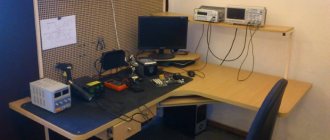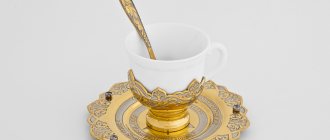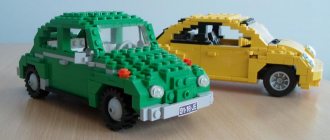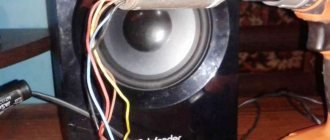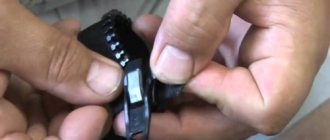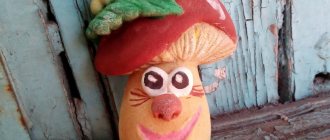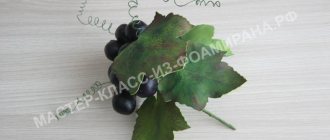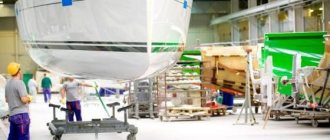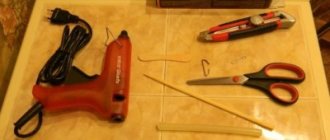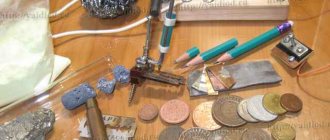Molecules from plasticine. Step-by-step sculpting lesson.
Today we will conduct a lesson not only in modeling, but also in chemistry, and we will make models of molecules from plasticine.
Plasticine balls can be imagined as atoms, and ordinary matches or toothpicks will help to show structural connections. This method can be used by teachers when explaining new material in chemistry, by parents when checking and studying homework, and by children themselves who are interested in the subject. There is probably no easier and more accessible way to create visual material for mental visualization of micro-objects. Here are representatives from the world of organic and inorganic chemistry as examples. By analogy with them, other structures can be made, the main thing is to understand all this diversity.
Materials for work:
1. Prepare plasticine for modeling spherical atoms from which molecules will be formed, as well as matches to represent the bonds between them. Naturally, it is better to show atoms of different types in a different color, so that it is clearer to imagine a specific object of the microworld.
2. To make balls, pinch off the required number of portions of plasticine, knead in your hands and roll into shapes in your palms. To sculpt organic hydrocarbon molecules, you can use larger red balls - this will be carbon, and smaller blue balls - hydrogen.
3. To form a methane molecule, insert four matches into the red ball so that they point towards the vertices of the tetrahedron.
4. Place blue balls on the free ends of the matches. The natural gas molecule is ready.
5. Prepare two identical molecules to explain to your child how the molecule of the next hydrocarbon, ethane, can be obtained.
6. Connect the two models by removing one match and two blue balls. Ethan is ready.
7. Next, continue the exciting activity and explain how a multiple bond is formed. Remove the two blue balls and make the bond between the carbons double. In a similar way, you can mold all the hydrocarbon molecules necessary for the lesson.
8. The same method is suitable for sculpting molecules of the inorganic world. The same plasticine balls will help you realize your plans.
9. Take the central carbon atom - the red ball. Insert two matches into it, defining the linear shape of the molecule; attach two blue balls, which in this case represent oxygen atoms, to the free ends of the matches. Thus, we have a carbon dioxide molecule of linear structure.
10. Water is a polar liquid, and its molecules are angular formations. They consist of one oxygen atom and two hydrogen atoms. The angular structure is determined by the lone pair of electrons on the central atom. It can also be depicted as two green dots.
These are the kind of exciting creative lessons you should definitely practice with your children. Students of any age will become interested in chemistry and will understand the subject better if, during the learning process, they are provided with a visual aid made by themselves.
Source
Operating principle
Before you start creating the Biefeld-Brown effect with your own hands, it is important to understand why this phenomenon occurs.
In strong electric fields, a corona discharge appears. This leads to ionization of air atoms near the sharp edges. In practice, 2 electrodes are most often used. The first has a thin and sharp edge, around which the electric field voltage reaches its maximum values. This is enough for air ionization to begin. The second electrode, on the contrary, has wide and smooth edges. For the effect to work, the voltage between the electrodes must be several tens of kilovolts (or even megavolts). The effect will disappear if a breakdown occurs between the electrodes. The diagram of the Biefeld-Brown effect is shown in the pictures.
Air ionization occurs near the sharp electrode. The resulting ions begin to move towards the wide electrode. As a result of their movement, they collide with air molecules, which leads to the transfer of energy from the ions to the molecules. The latter either begin to move faster or themselves turn into ions. This results in an air flow from the sharp electrode to the wide one. The force of this flow is enough to lift a small model into the air. This device is usually called an ion plane or lifter.
The experiments carried out show that the Biefeld-Brown effect does not work in a vacuum. The presence of a gaseous medium is a prerequisite for the creation of a phenomenon.
Thomson model
The first model of the structure of the atom was invented by the English physicist Joseph John Thomson (who was awarded the Nobel Prize for the discovery of the electron). Ultimately it turned out to be incorrect, but it played an important role in being the impetus for Rutherford's subsequent experimental research. Physicists called Thomson's model "raisin pudding."
According to Thomson, an atom is a ball with a size of the order of cm. A positive charge is distributed in some way throughout this ball, and inside the ball, like raisins, there are electrons (Fig. 1).
Rice. 1. Thomson's atomic model
The total charge of the electrons is exactly equal to the positive charge of the ball, so the atom as a whole is electrically neutral.
The radiation of atoms is explained by the vibrations of electrons around equilibrium positions (as you remember, any accelerating charge emits electromagnetic waves). However, the entire set of experimental data on atomic spectra did not fit into Thomson’s model. For example, for some chemical elements formulas were selected that well described their spectra, but these formulas did not follow Thomson’s model in any way.
Preparatory stage
Before you do a perm at home, you need to prepare for it. Twenty days before the event you cannot dye your hair. It would be a good idea to conduct a drug sensitivity test before perming. To do this, apply a little product behind the ear and wait a day. If no allergic reaction occurs, the product can be used; conversely, if there is irritation or rash, it is better to stop using the drug.
Before this event, you should see how the chemical reagent will act on your hair. To do this, a small curl is treated with a curling compound. If after a couple of minutes the strand breaks, then the concentration of the solution is halved. The procedure is repeated on another strand. If your hair still breaks, then you need to give up perm and pay attention to restoring and strengthening your hair.
All products for this event must match your hair type. For long bobbins, choose a larger diameter, for short ones - a smaller one. Be sure to evaluate the condition of your hair before curling. Weak strands should not be subjected to such an event.
Tools for work
Before you do a perm at home with “Lokon”, you need to prepare your tools. For the procedure you will need:
- a comb with sparse teeth and a pointed end;
- curlers with a lock or bobbins of the required diameter, about 50-80 pieces;
- non-metallic containers;
- foam sponges;
- plastic clips;
- beaker;
- gloves and headband;
- cellophane cap;
- two towels.
To create curls, you can use not only “Lokon”, but also ready-made perm kits.
In addition to tools, you will need citric acid or vinegar in a concentration of 6% or 9%, shampoo, restoring balm, which is applied to the hair after “chemistry,” nourishing cream or Vaseline.
What is around the atom?
To understand how to draw an atom, you need to determine what its appearance is. Electrons, that is, small balls that were drawn in the previous paragraph, move around protons, that is, larger circles. Therefore, they have their own trajectory or path. It is depicted as ellipses that pass through electrons. Ellipses are the route of small particles.
These elongated ovals are placed across the main circle, crossing each other. On average, you can get about three such circles. If it is difficult to draw circles so that they intersect the electrons, then you can first draw these paths and then place the electrons on them.
Now you can erase all the pencil sketches, highlight with a clear line what should remain, and color the atom itself.
In a general sense, the pattern of an atom is a collection of small circles circling around a center of larger balls. This is our atom, and now everyone knows how to draw it. You can color it however you like!
Let's consider the structure of water
1. To create structural units, prepare plasticine; to simulate bonds between atoms, use ordinary matches.
2. Any substance consists of molecules, and those, in turn, of atoms. If the composition includes atoms of only one element, then such a substance is called simple; if the composition includes atoms of two or more elements, then the substance is complex. A water molecule consists of 1 oxygen atom and 2 hydrogen atoms, that is, it is complex. But that is not all.
The most important advantage of this liquid is its polarity. It is achieved due to the presence of a lone pair of electrons that oxygen holds near itself. To depict the structure of one molecule, you will need 1 large bead to imitate oxygen (in this case, blue), 2 small beads for hydrogen (pink), 2 small beads for electrons (yellow).
3. To combine oxygen with hydrogen, insert matches into the blue ball. The question arises of how exactly to arrange the chemical bonds. The shape of the water molecule is angular, so you need to insert the matches at some angle, and not opposite each other. This occurs due to the fact that the hydrogens that are at the ends of the bonds are repelled from the electrons held by the oxygen.
4. Assemble the molecule. Glue the yellow beads to the blue ball and the pink pieces to the ends of the matches. Look carefully at what you get - this is a model of the structure of water. Oxygen has electrons because it is larger and greedier than hydrogen. He pulls these small particles towards himself. We should consider the offended hydrogens as positive heroes (they carry a + charge after oxygen has taken their electrons), let the second atom be negative.
5. To consider different states of aggregation of water, it is necessary to create not one, but several molecules. Make a lot of blue and pink balls, and you won't need matches anymore.
6. Glue pink ones to the blue balls to imitate the structure of water.
7. If water is steam, its molecules are very far from each other, they are not connected to each other, but move at high speed through the space in which they are located.
8. In the liquid state, the molecules are connected, but in separate groups, which, as if dancing in a circle, move one relative to the other.
9. We know solid water in the form of ice or snow. In such a structure, all molecules are connected to each other, do not move, but only vibrate, trying to escape. And structural units in the form of hexagons are connected.
Source
Orange roses - decor and flavoring
Orange peels make excellent roses that can be used for decoration and as a natural home fragrance.
Ready-made roses, as well as dried orange and lemon slices, can be placed in a vase like this (found in my grandmother’s pantry - almost thrown away)))
To make the aroma brighter, take lemon essential oil and drip a few drops onto the roses in the vase. And it’s beautiful - the smell lasts about 3 weeks, when it dissipates, we repeat the procedure.
In order to make orange roses with your own hands you need:
Literature
- Pyramid chaos. (2007). "Computerra". 692;
- At the dawn of molecular graphics;
- A new milestone: the spatial structure of the β2-adrenergic receptor has been obtained;
- Bird, K. (2007). “4isla” with meaning. "Computerra". 684;
- Edgar E Meyer. (1997). The first years of the Protein Data Bank. Protein Sci.
.
6 , 1591-1597; - Zorkiy P.M. (2001). Linus Pauling is the greatest chemist of the 20th century. Moscow State University;
- James Watson lost his laboratory because of his recent statements;
- Chugunov A.O. (2007). Statue of the invisible. "Computerra". 712, 24–26.
Basic painting
There are two main ways to paint models: brush painting and airbrush painting. Painting with an airbrush gives a better result, but requires the purchase of quite expensive equipment, and this is not always available, especially for young modelers. A brush requires much less expense, but achieving an acceptable result, in my opinion, is more difficult.
But modelers use both methods in their work, so mastering the brush is extremely important and necessary. Paint for painting with a brush, as mentioned above, is best to buy the one specified by the manufacturer. If this brand is not available in your region, you can choose an analogue. Consultants in any store will be happy to help you.
For beginners, I advise you to use water-based acrylic paints (Tamiya, Gunze Sangyo, etc.). They do not have a strong odor and are easier to clean. It is necessary to note that there are paints that are immediately prepared by the manufacturer for use in an airbrush, for example Vallejo Model Air series. I do not recommend such paints for brushes (too liquid). The basic painting can also include camouflage painting, preshading (darkening the recesses and depressions on the model), highlighting (highlighting the protruding parts of the model with a lighter tone of the base color).
After painting, the model must be allowed to dry for 24 hours.
hydrogen:
Note that the mass of the resulting “atoms” is increased by 1000,000,000,000,000,000,000,000 (10 to 24 powers) times compared to the real ones.
In terms of size, it turned out that the oxygen atom is “similar” to a plum, and the hydrogen atom is like a pea.
In a water molecule, two hydrogen atoms and one oxygen atom are located quite close to each other, but at a certain angle. If we mark the “center” of the oxygen atom with a dot and attach the central mark of a protractor to it, then the hydrogen atoms will be at an angle of 104 degrees relative to each other.
As a result, we got this model of a water molecule:
Source

